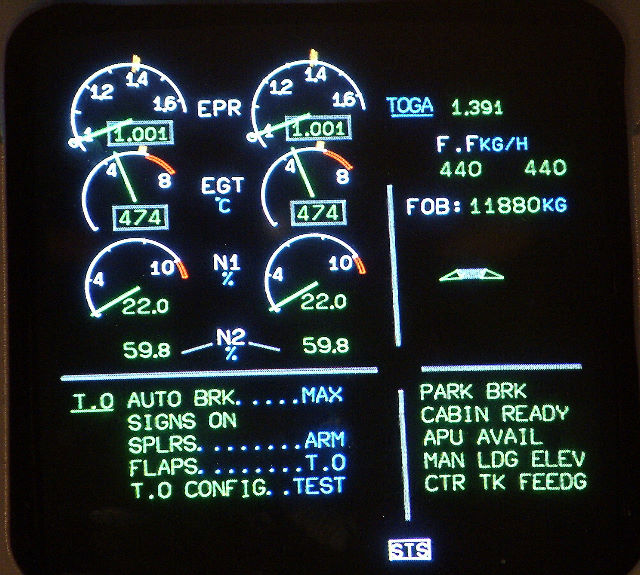
Electronic Centralised Aircraft Monitor (ECAM) is a system that monitors aircraft functions and relays them to the pilots. It also produces messages detailing failures and in certain cases, lists procedures to undertake to correct the problem.
History
ECAM is similar to another system, known as Engine Indicating and Crew Alerting System (EICAS), used by Boeing and others, which displays data concerning aircraft systems and also failures. Airbus developed ECAM, such that it not only provided the features of EICAS, but also displayed corrective action to be taken by the pilot, as well as system limitations after the failures. Using a colour coded scheme the pilots can instantly assess the situation and decide on the actions to be taken. It was designed to ease pilot stress in abnormal and emergency situations, by designing a paperless cockpit in which all the procedures are instantly available. This reduces the required cockpit crew to two pilots. This development means that in modern aviation flight engineers are no longer necessitated.
System Design
ECAM is actually a series of systems designed to work in unison to display information to the pilots in a quick and effective manner. Sensors placed throughout the aircraft, monitoring key parameters, feed their data into two SDACs (System Data Acquisition Concentrator) which in turn process the data and feed it to two FWCs (Flight Warning Computers.) The FWCs check for discrepancies in the data and then display the data on the ECAM displays through the three Display Management Computers (DMC). In the event of a fault the FWCs generate the appropriate warning messages and sounds. More vital systems are routed directly through the FWCs such that failures in them can still be detected even with the lose of both SDACs. The whole system can continue to operate even with a failure of one SDAC and one FWC.
Failures are classed by importance ranging from level 1 failures to level 3 failures. In the event of simultaneous failures the most critical failure is displayed first. The warning hierarchy is as follows:
Level 3 Failures – Red Warnings, situations that require immediate crew action and that place the flight in danger. For example an engine fire or loss of cabin pressure. They are enunciated with a red master warning light, a warning (red) ECAM message and a continuous repetitive chime or a specific sound or a synthetic voice. The chime can be silenced by pressing the master warning push button.
Level 2 Failures – Amber Cautions, failures that require crew attention but not immediate action. For example air bleed failure or fuel fault. They have no direct consequence to flight safety and are shown to the crew through an amber master caution light, a caution (amber) ECAM message and a single chime.
Level 1 Failures – Cautions, failures and faults that lead to a loss of system redundancy, they require monitoring but present no hazard. Examples include the loss of DMC3 when not in use. Level 1 failures are enunciated by a caution (amber) ECAM message only (no aural warning).
